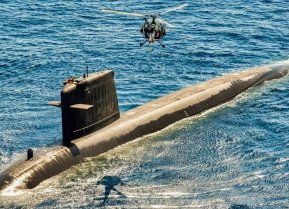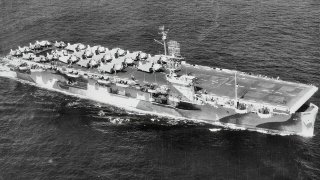The U.S. Navy Built an Astounding 50 Casablanca-Class 'Escort' Aircraft Carriers
The Casablanca-class escort carrier holds a notable distinction: more Casablancas were built than any other type of aircraft carrier class ever.
The Casablanca-class escort carrier holds a notable distinction: more Casablancas were built than any other type of aircraft carrier class ever.
In just two years, 50 Casablancas were launched and commissioned into the US Navy.
Yet, sadly, despite the completion of so many Casablancas, not one example of the carrier survives today – five were lost in combat while the remaining 45 were scrapped.
The origin of the Casablanca
Even though the Casablanca is a straightforward machine relative to modern supercarriers, building 50 aircraft carriers is no small feat (nor a cheap feat).
The reason for the building spree: World War II. Few events could inspire such a massive shipbuilding spree (the 50 Casablanca made up just about one-third of the 143 aircraft carriers that the US built during World War II) – but World War II met the prerequisites; World War II was a cataclysmic event with existential ramifications, perhaps the most consequential single event in human history. The US engaged in conflict on two fronts simultaneously and spared nothing.
The US population was mobilized for total war in a way that would likely seem shocking to those of us who have lived through relatively passive efforts in Panama, Somalia, Iraq, Afghanistan, et cetera. The US civilian population was calibrated to provide maximum industrial output.
Tax revenues were funneled into defense spending, without frugality. To combat the threat of Imperial Japan in the Pacific Theater and the threat of the Nazi Kriegsmarine in the Atlantic, US industrial output/defense investment was put, in large part, toward shipbuilding. The Casablanca-class represented a significant portion of the US’s World War II era industrial effort.
The Casablanca-class was constructed at Kaiser Shipbuilding Company’s Vancouver Yard, on the Columbia River in Vancouver, Washington. The Vancouver shipyard was originally meant to build Liberty cargo ships, but before long, the yard was being used to construct LST landing craft and escort carriers like the Casablanca.
To meet the demands of the Pacific Theater and the Battle of the Atlantic, Henry Kaiser proposed that the Casablanca be mass-produced using assembly-line techniques.
“Following the Pearl Harbor raid, it was evident that carriers would rule the seas,” defense expert Sebastian Roblin wrote, “but forthcoming Essex-class fleet carriers were years away from entering service. Kaiser was already assembling large “Liberty Ship” transports in just six weeks on average, and he promised to launch small escort carriers in just three months using interchangeable-part production techniques.”
Initially, the Navy was not interested in Kaiser’s Casablanca because the escort carrier would be slow (20 knot max speed) and small (able to carry just one-third the aircraft of a typical fleet carrier). But Kaiser went over the heads of the Navy, appealing to President Franklin Delano Roosevelt himself. Roosevelt approved of the plan.
“With Roosevelt’s support, Kaiser’s shipyard in Vancouver, Washington, began construction of lead ship Casablanca in November 1942,” Roblin wrote. “Between April 5, 1943, and May 27, 1944, [Kaiser’s] shipyards launched fifty brand-new escort carriers – nearly one per week!”
The service of the Casablanca
The Casablanca was indeed small. Measuring just 511 feet and displacing just 11,000 tons when fully loaded with 910 crew, 28 aircraft, and 120,000 gallons of fuel, the Casablanca was notably smaller than her Essex-class cousin. (For a point of reference, consider that a modern-day Nimitz-class carrier measures 1,092 feet and displaces around 100,000 tons).
Now, you’d think that a smaller carrier would compensate with speed. But the Casablanca’s uniflow reciprocating engines were only capable of pushing the boat to a maximum speed of 20 knots. The Casablanca was only lightly armored and tended to roll dramatically in rough seas. In all, the Casablanca was a quirky boat – but she served venerably.
“The Casablanca class’s finest hour came in the Battle of Samar, when sixteen CVEs and their escorts covering the amphibious landing at Leyte Gulf single-handedly took on a Japanese battlefleet consisting of four battleships and nineteen cruisers and destroyers,” Roblin wrote for the National Interest. “In a frantic few hours, the carriers’ combined air wings and self-sacrificing destroyer escorts managed to sink three cruisers and persuade Admiral Takeo Kurita to withdraw.”
The legacy of the Casablanca Escort Aircraft Carriers
Today, not a single Casablanca survives. Five Casablancas were sunk in battle (a large proportion of the 11 US aircraft carriers sunk during World War II. The sunk Casablancas include: Liscome Bay (torpedo); Gambier Bay (surface gunfire); St. Lo (kamikaze); Ommaney Bay (kamikaze); and the Bismarck Sea (kamikaze).
After World War II, a few surviving Casablancas were used as aircraft transports. But most of the class was decommissioned in 1946. Each and every Casablanca was eventually scrapped, meaning that not a single example of the most numerously built aircraft carrier ever exists today.
About the Author
Harrison Kass is a defense and national security writer with over 1,000 total pieces on issues involving global affairs. An attorney, pilot, guitarist, and minor pro hockey player, Harrison joined the US Air Force as a Pilot Trainee but was medically discharged. Harrison holds a BA from Lake Forest College, a JD from the University of Oregon, and an MA from New York University. Harrison listens to Dokken.


